Nestled in the heart of Hanoi, the Vietnam Military History Museum stands as a beacon of the nation’s enduring legacy and military prowess. This museum, established in the mid-20th century, offers a deep dive into Vietnam’s tumultuous yet triumphant past, encapsulating eras of resistance against foreign invasions, colonialism, and revolutionary wars.
The museum’s sprawling complex spans 12,800 square meters, meticulously showcasing over 150,000 artifacts that narrate the fascinating stories of strategic genius and valor. From ancient military tactics to modern-day conflicts, every corner of this museum echoes the nation’s journey toward independence and unity. Visitors entering this historic venue embark on a narrative journey, tracing the transitions and transformations of Vietnam’s military history while appreciating the symbolic and tangible legacies left behind.
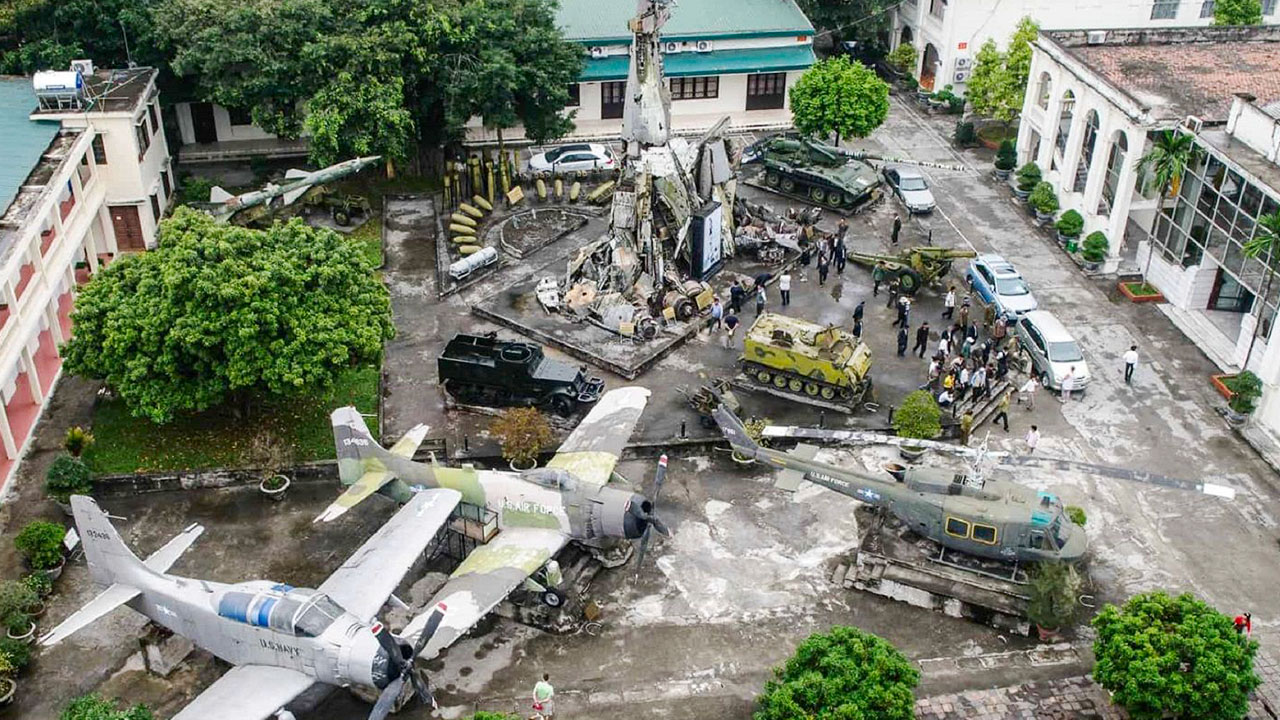
Layered with historical significance, the museum’s strategic location in Hanoi places it near other prominent landmarks such as the Ho Chi Minh Mausoleum and the Lenineseque State, offering an enriched cultural landscape that captivates locals and tourists alike. The Vietnam Military History Museum is more than just a repository of relics; it is a testament to the undying spirit of the Vietnamese people and a tribute to the sacrifices made in the pursuit of sovereignty. As you traverse this museum, you get to not only witness artifacts of national pride but also unlock stories that shape Vietnam’s identity today.
Location and Accessibility
Located centrally in Hanoi at 28A Điện Biên Phủ, Ba Đình District, the Vietnam Military History Museum boasts both strategic and symbolic significance. Its proximity to iconic landmarks like the Ho Chi Minh Mausoleum and Lenin Park renders it an accessible cultural hub for both locals and international tourists. Getting to the museum is seamless, thanks to an array of public transportation options and its user-friendly facilities, including ramps and elevators catering to visitors with mobility challenges. This strategic placement in the heart of Hanoi enriches the visitor experience by providing a confluence of Vietnam’s vibrant cultural and historical tapestry.
The location of the museum not only underscores its importance within the city’s urban landscape but also facilitates easy access for those keen to explore Vietnam’s extensive military past. It serves as a poignant reminder of the historical struggles and triumphs etched in every corner of the city. When planning a visit, understanding the routes and modes of accessibility ensures a smooth journey to this beacon of Vietnam’s resilience.
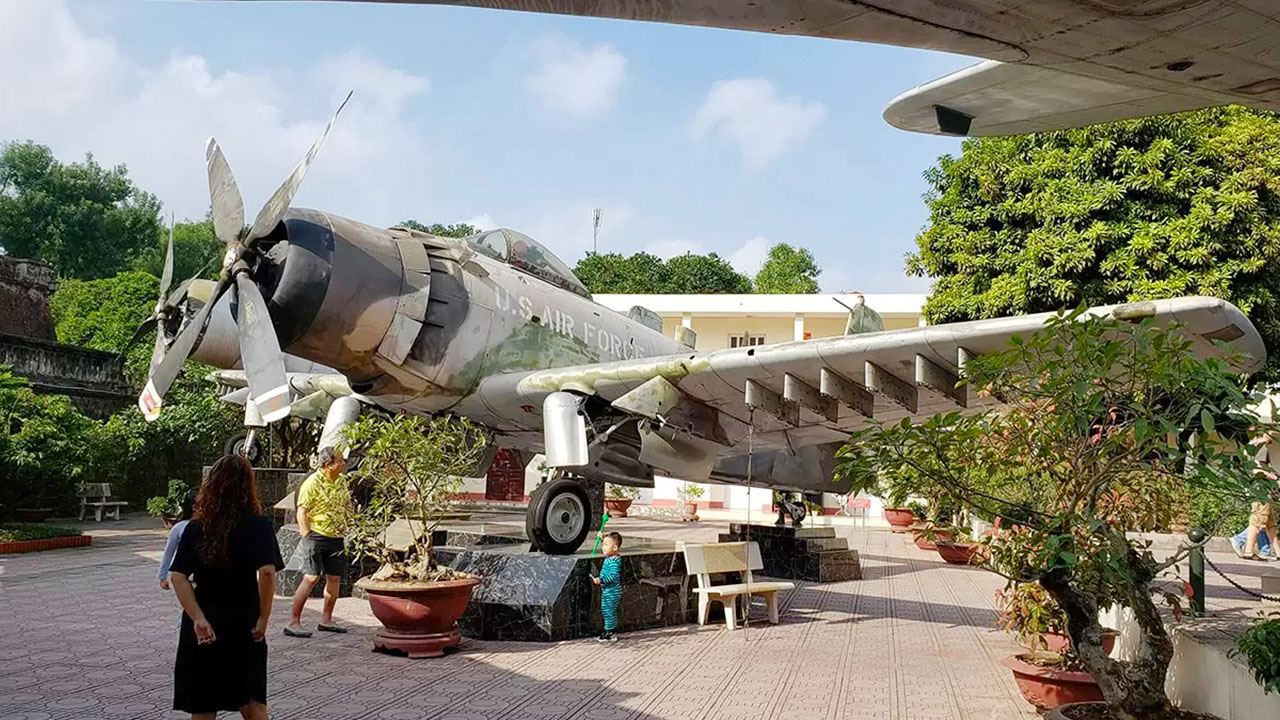
Address and Directions
Hanoi, a city that brims with layers of history, holds in its heart the Vietnam Military History Museum, strategically located at 28A Điện Biên Phủ, Ba Đình District. This museum is not just a mere building but a powerful emblem of Vietnam’s revolutionary past and indefatigable spirit. Its address stands prominently among significant historical landmarks, enveloping visitors in a sense of history as soon as they set foot in its vicinity. The museum lies conveniently close to busting nodes of transit, ensuring that each guest can find their way easily without any disruption.
For those relying on public or private transportation, the museum is well-serviced by Dien Bien Phu and Nguyen Tri Phuong bus routes, giving travelers the simplicity of hassle-free entry. Buses, an economical choice for many, stop just a few steps away from the museum, easing the entry for curious visitors ready to delve into Vietnam’s military bygone eras. Alternatively, taxis and motorbike taxis offer a quick conveyance for those eager to explore without the constraints of bus schedules. Taxi drivers in Hanoi are generally well-versed with the local attractions, and the museum, located close to the city center, is a popular destination.
For those who favor the freedom and flexibility of private vehicles, parking is readily available. This ensures that the museum remains accessible to all, regardless of the chosen mode of transport. Indeed, part of the museum’s charm lies in its central location, placing it in convenient juxtaposition with other notable attractions within Hanoi’s historic core. The juxtaposition of ancient and contemporary is felt not just in the city’s landscape but also in the stories woven throughout the museum’s hallowed halls.
In essence, the directions to the Vietnam Military History Museum are as layered as the stories told inside. They invite you to embark on a journey through time, from the bustling Hanoi streets into the echoes of Vietnam’s proud military past.

Public Transportation Options
Navigating Hanoi to reach the Vietnam Military History Museum is a straightforward affair, thanks to the city’s extensive public transportation network. Buses form the backbone of this system, ensuring easy connectivity to this historic site. The museum is well-serviced by several city bus routes, such as routes 9, 18, 41, and 45. Each of these buses provides a seamless connection from various parts of the city to the cultural heart where the museum is located.
Those opting for buses will find Dien Bien Phu and Nguyen Tri Phuong to be practical stops, placing you a mere few minutes’ walk from the museum. These buses offer an affordable way to travel for both short commutes and longer journeys across Hanoi, providing not just transport but a view into the city’s vibrant daily life. Equipped with air conditioning, buses offer comfortable rides a welcome relief from the tropical heat.
For those preferring alternative public options, motorbike taxis (locally known as “xe om”) and traditional taxis are plentiful throughout Hanoi. These options afford more flexibility, allowing guests to experience the city up close while maneuvering through bustling streets and narrow lanes. Moreover, apps like Grab enable rapid online bookings, offering a digital ease to rival any street-corner taxi stand.
Navigating to the museum using public transport reflects Hanoi’s blend of traditional charm and modern convenience. The simplicity of reaching the museum encourages spontaneous exploration, enhancing accessibility for travelers with disparate itineraries and transcends beyond mere transportation. This ease of access, courtesy of Hanoi’s comprehensive public transport framework, makes the Vietnam Military History Museum an accessible treasure for any exploring soul eager to experience Vietnam’s storied past.
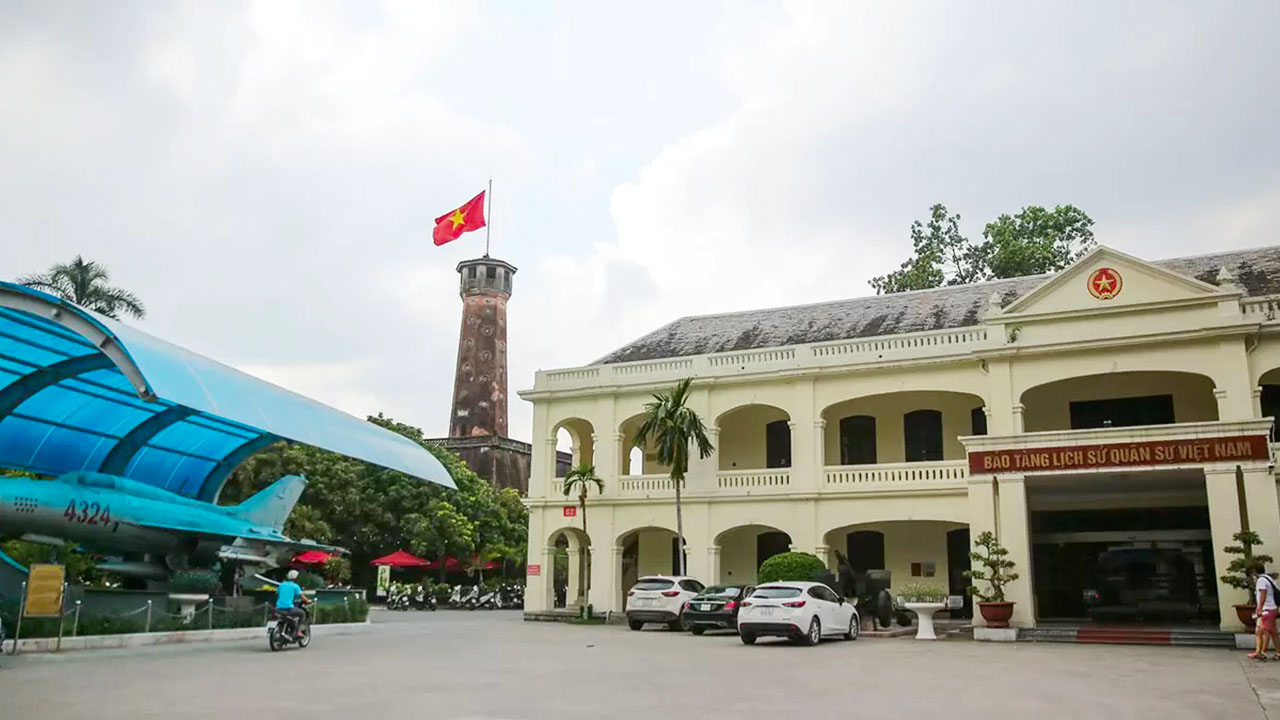
Historical Significance
In the heart of Hanoi, visitors are welcomed not only by the bustling city but also by the Vietnam Military History Museum, a monumental avenue of history. With its strategic location near other historical sites like the Ho Chi Minh Mausoleum, the museum exudes profound significance in commemorating Vietnam’s military legacy. This artifact-laden museum provides a detailed journey through the phases of Vietnamese military history, from ancient times to modern-day conflicts, reflecting the resilience and strategic ingenuity that defines the nation.
The museum’s historical significance extends beyond physical artifacts and into the essence of its existence. Founded to preserve and attune future generations to the experiences and lessons of the past, the museum effectively captures and showcases Vietnam’s storied struggles and victories. Each exhibit, a testament to pivotal moments in national and global history, portrays the shared narratives of courage and determination.
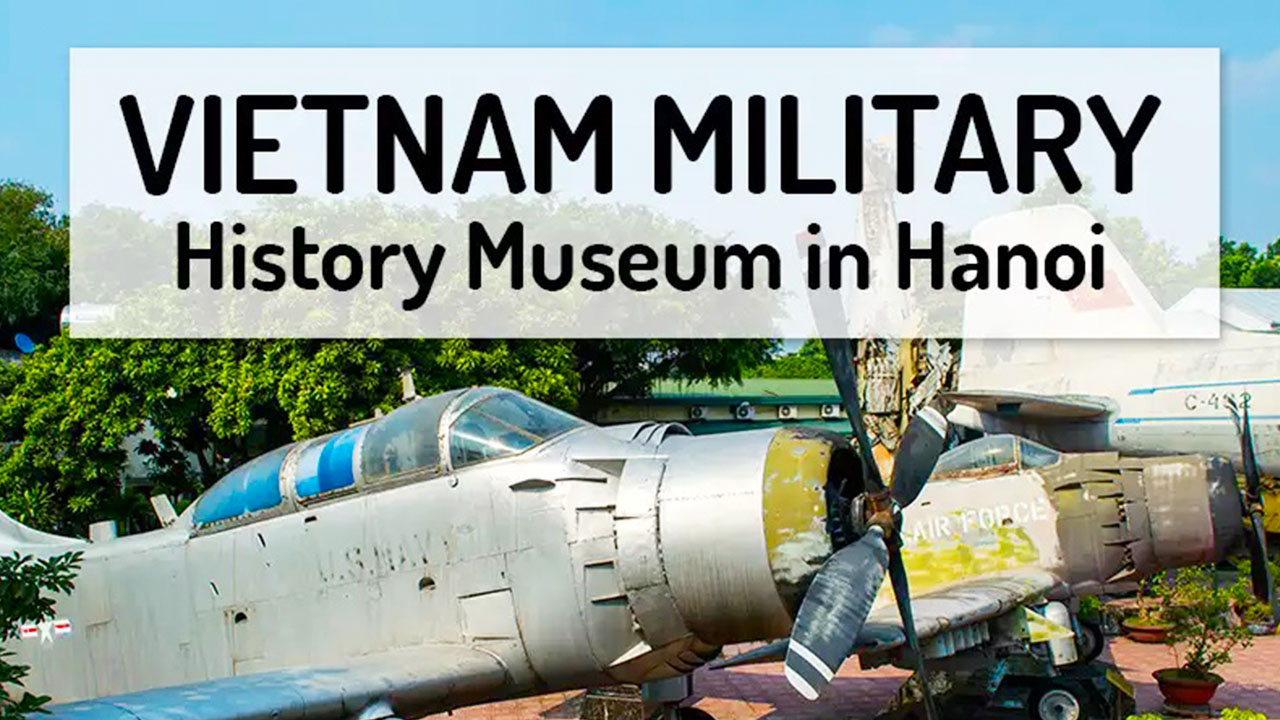
Establishment and Founding Date
The establishment of the Vietnam Military History Museum is steeped in historical significance, beginning on July 17, 1956. A progression initiated by the Vietnamese government amidst a period of national consolidation and recovery, the museum was conceived as a means to immortalize the hard-fought milestones of Vietnam’s military prowess. Its official inauguration on December 21, 1959, was synchronously aligned with the 15th anniversary of the founding of the Vietnam People’s Army. This calculated timing amplified the museum’s importance, serving as a symbol both political and cultural, commemorating the indomitable spirit of Vietnam’s armed forces.
The museum was purposefully constructed to enshrine and educate visitors about Vietnam’s extensive and storied martial past. Its foundation laid amidst the backdrop of modernizing Hanoi, the museum served as a repository of Vietnam’s rich legacy of battle and victory. Central to its existence is the aim to educate citizens and visitors about the resilience and sacrifices woven into the history of Vietnam’s journey towards independence and unity.
The inception of the museum marked a vigorous effort to preserve historical narratives through vast collections of artifacts, documents, and interactive exhibits. These elements collectively provide insight into periods of colonization and conflict, which have indelibly shaped modern Vietnam. Throughout its decades of operation, the museum has curated and expanded its collection to over 150,000 items, each holding unique historical and pedagogical value.
The founding of the Vietnam Military History Museum was a deliberate act to reinforce national identity through the lens of military history. With its extensive collection symbolizing transformative periods such as the Battle of Dien Bien Phu and the Vietnam War, the museum extends an invitation for exploration and reflection on historical truths and patriotic sentiments that underlie Vietnam’s past. It is not merely a memorial but a vibrant societal narrative enshrined within Hanoi’s cultural landscape.
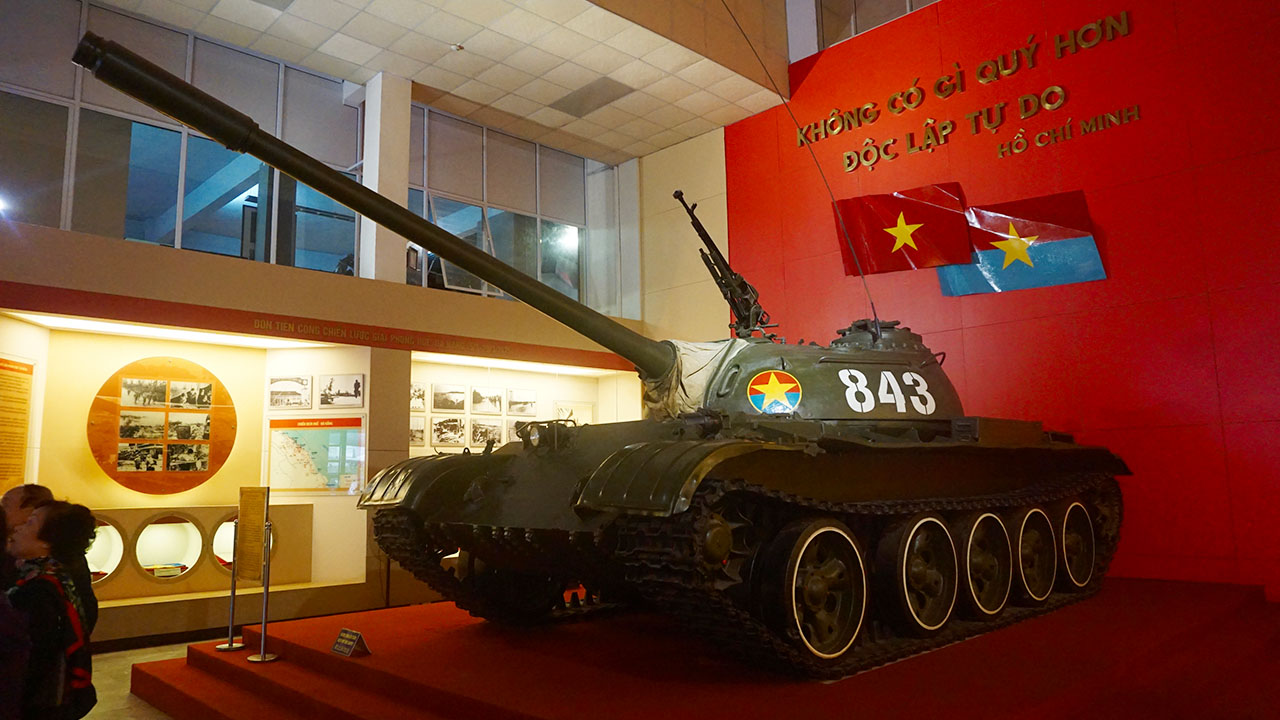
Major Historical Events Represented
The Vietnam Military History Museum stands as a guardian of narratives detailing Hanoi and Vietnam’s past, spanning centuries and highlighting key historical events. The museum’s vast array of exhibits encapsulate pivotal moments, each showcasing Vietnam’s relentless spirit in the face of adversity. From ancient conflicts against Mongol invasions to fending off colonial powers, the museum is a treasure trove of stories and artifacts, each recounting seminal chapters in the nation’s history.
Notably, the museum renders an immersive portrayal of Vietnam’s struggle against French colonial rule through captivating displays chronicling periods such as the resistance from 1858 to 1954 and the seminal Battle of Dien Bien Phu. Here, visitors are afforded a vivid understanding of Vietnam’s intricate strategic maneuvers and tenacity, attributes that proved pivotal in overturning colonial domination. A delicate yet powerful juxtaposition, these narratives inform and inspire contemporary understandings of Vietnam’s hard-won sovereignty.
Similarly, the galleries dedicated to the Vietnam War showcase not just military hardware and strategies but also personal accounts and documents which paint a comprehensive picture of the period from 1954 to 1975. These exhibitions delve into the human stories behind military conquests, highlighting courage, sacrifice, and the unyielding drive toward national reunification.
Beyond these two cornerstone events, the museum’s collection envelopes countless other pivotal moments, each with a detailed backdrop against which Vietnam’s story unfolds. From the women warriors who took up arms in the face of invasion to the guerilla tactics that navigated primeval jungles, every exhibit weaves into the unbreakable fabric of Vietnam’s military legacy. These representations in the museum’s galleries conjure not just interest but a profound understanding of how Vietnam has, through sheer resilience and strategic depth, carved its identity on the global stage.

Exhibits and Artifacts
As the Vietnam Military History Museum beckons visitors with an array of historical artifacts and exhibits, its historical significance reverberates through the vast halls and display settings. Each exhibit is a portal to a bygone era, bearing witness to the battles fought and won by a determined people. The artifacts, emerge as venerated symbols, chronicling stories of sacrifice, strategy, and survival that have collectively sculpted Vietnam’s identity. The museum’s diverse display invites a deeper exploration and appreciation of the past, its encounters, and influences.
Each carefully curated artifact and exhibit within the museum not only invites scrutiny and learning but seeks to evoke a sense of connection to Vietnam’s storied journey towards sovereignty and national pride. Walking through the exhibition halls, one can discern the mosaic of historical markers that collectively paint Vietnam’s vibrant military past.
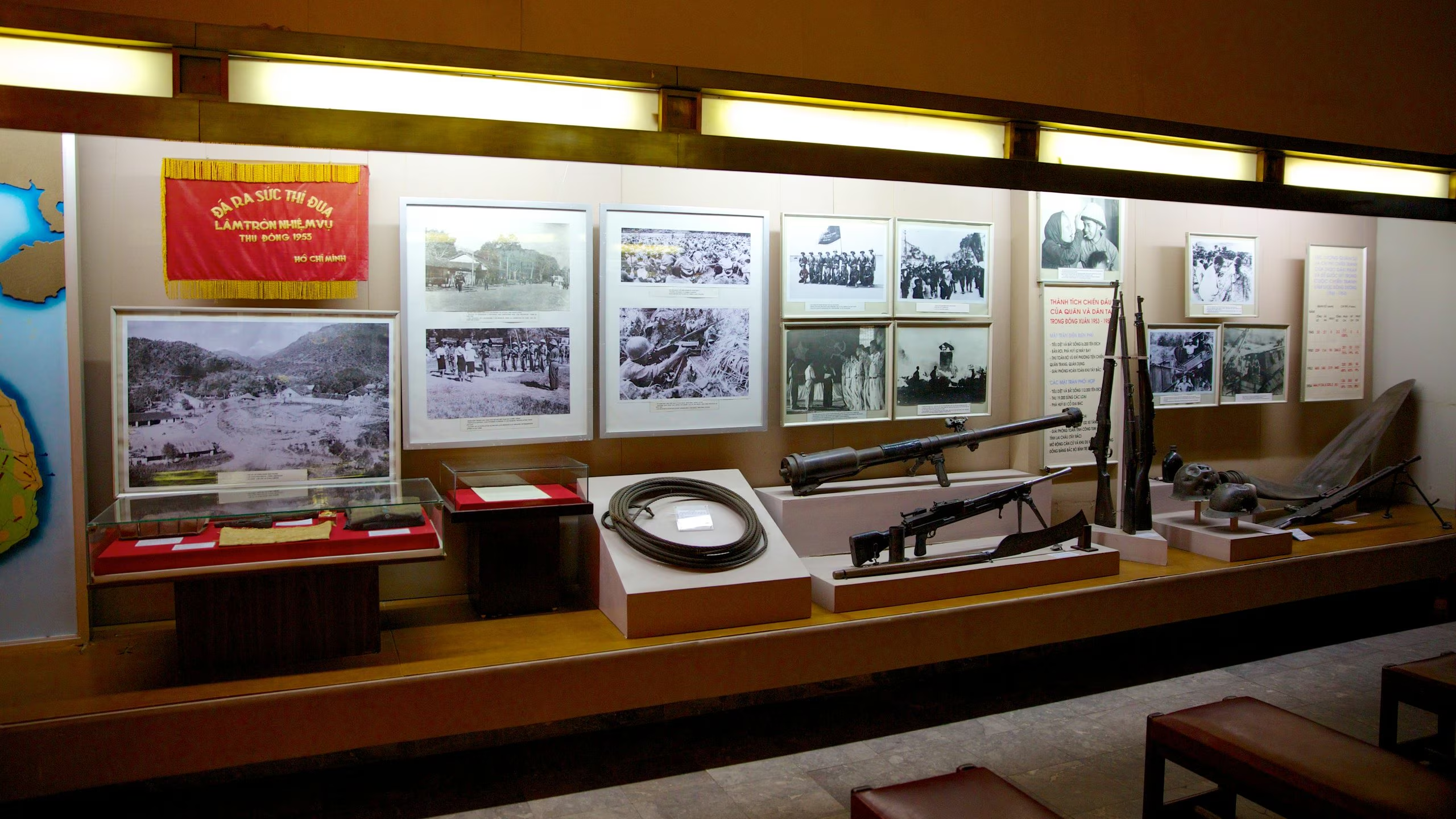
Overview of the Exhibition Halls
The Vietnam Military History Museum intricately weaves its narratives through three main exhibition halls, each providing a distinctive thematic experience of the nation’s military past. Hall One, themed “Vietnam’s Struggle for Independence,” captivates visitors with its impressive collection of vital artifacts from battles against foreign invaders. Delving into the timeline, the hall recounts tales from the period of the Hung Kings’ reign to the victory that marked the halt of the First Indochina War in 1954. Here, notable items include weapons employed in the Trung Sisters’ rebellion and compelling accounts chronicling the heartbeat of the August Revolution of 1945.
Embarking next, Hall Two focuses intensively on “Vietnamese Military Tactics and Weapons.” This section of the museum sheds light on the country’s military innovation and strategic evolution over centuries. Exhibits in this collection boast an assembly ranging from traditional swords to modern artillery and military vehicles used in pivotal conflicts, offering a structured narrative of Vietnam’s ingenious military technology adapted through epochs.
Moving forward, Hall Three captures the exigencies of the 20th Century by reflecting on the Vietnam War’s indelible impact on the country. This hall is a repository of poignant photographs, soldiers’ personal artefacts, and a meticulous replica of the formidable Ho Chi Minh Trail. These exhibits hence draw a vivid narrative of the challenges confronted by the Vietnamese army during the war and of the resolute sacrifices made by warriors.
Aside from the immersive indoor exhibits, the museum also extends its stories into an outdoor array of military paraphernalia, encompassing helicopters, tanks, and artillery. These displays add layers of tangible history to engage visitors, making the museum a multidimensional space filled with stories of endurance, bravery, and ingenuity inherent in Vietnam’s martial past.

Featured Artifacts and Their Importance
Every artifact within the Vietnam Military History Museum holds a narrative that transcends time, reflecting the indomitable spirit and resilience of Vietnam’s military history. Among the multitude of exhibits, several artifacts stand as iconic emblems of the galaxies of struggle and victory witnessed throughout the nation’s history. Each serves as a testament to the depth of military evolution and the strategic genius that has defined Vietnam on the global stage.
One of the most significant artifacts is the T-54B tank, famously known for storming the Presidential Palace in Saigon in 1975, signaling the culminating moment of victory during the Vietnam War. Its presence in the museum is not only historical but serves as a tangible reminder of strategic success and determination. Another cornerstone artifact is the MiG-21 aircraft, a symbol of aerial strength that played a critical role in Vietnam’s air defense during confrontations against technologically superior forces.
The museum also hosts remnants of the Bak Dang Battle Wooden Wattles from 1288, a resonate symbol of the ancient military strategies utilized against the Mongol invaders under general Tran Hung Dao. These wattles demonstrate extraordinary foresight and tactical ingenuity, forever enshrined in Vietnam’s rich historical narrative.
Artifacts from the Indochina War, including shell mines and infrared optics, bring forward tales of technological resourcefulness exhibited during periods of intense hostility. Among these, the portraits and personal belongings of soldiers shed light on the personal experiences and sacrifices that bolstered Vietnam’s path to freedom.
Collectively, these featured artifacts create compelling narratives that are both educational and commemorative, unfolding pages of Vietnam’s historical timeline. Through these storied items, visitors are not only informed but also inspired, gaining appreciation for the resilience embodied by each relic, each a marker of a monumental period in Vietnam’s pursuit of sovereignty and unity.
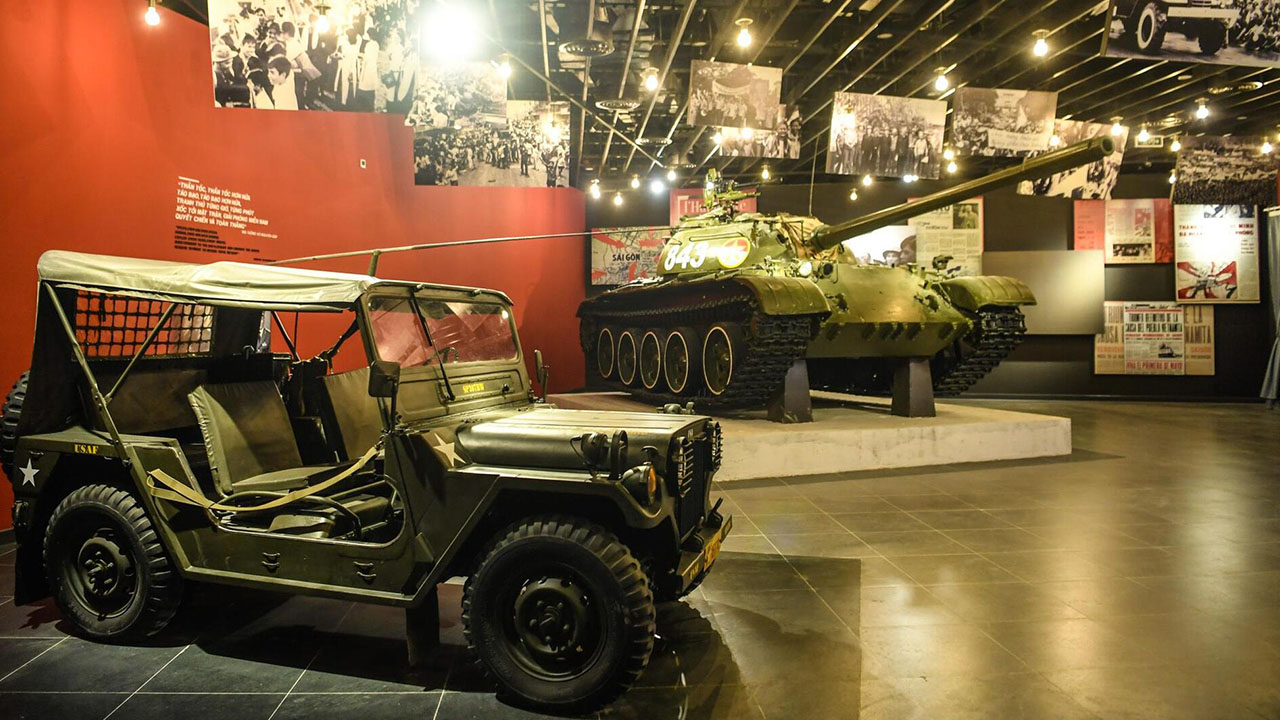
Outdoor Displays and Military Equipment
A stroll through the Vietnam Military History Museum reveals yet another facet of its captivating exhibits the outdoor displays. Nestled around the historic Flag Tower of Hanoi, these outdoor exhibits offer a larger-than-life immersion into Vietnam’s military past, allowing visitors to engage closely with its significant artifacts and decommissioned military equipment. Often referred to as the “Garden of Toys,” this area emerges not only as a showcase of military hardware but also as a symbolic representation of the tenacity and tactical brilliance inherent in the Vietnamese military tradition.
Prominently exhibited within this area are tanks, artillery pieces, and the remnants of fallen aircraft, such as the tail section of an American F-111A. These pieces unveil the robust defense strategies employed by Vietnam and exemplify the ability to confront superior forces with lesser technology yet strategically secure victories. The Soviet-era T-34 and T-54 tanks capture the essence of Vietnam’s military might and technological advancements achieved over decades.
The juxtaposition of these military behemoths against the serene backdrop of Hanoi creates a setting that is both contemplative and evocative. Each artifact in the outdoor display serves as a dramatic reminder of sacrifices rendered and battles waged in the pursuit of freedom and independence.
Through these outdoor exhibits, visitors are given access to tangible connections with Vietnam’s military history, offering a vantage point from which to appreciate not only the equipment itself but also the stories of those who piloted and manned them in times of strife. Collectively, these displays deepen an understanding of the complexities involved in Vietnam’s conflicts, shaping a comprehensive and compelling narrative of resilience and perseverance.
Visitor Experience
Visiting the Vietnam Military History Museum exposes guests not only to the wealth of historical artifacts and exhibits within its walls but also to an enriched and informative encounter with Vietnam’s rich military heritage. The halls echo the perseverance embedded within the nation’s culture while fostering an interactive and reflective visitor experience. The journey from aspect to aspect within the museum elucidates Vietnam’s transformative struggles and strategic prowess, creating a dialogue between past and present.
The sense of history is palpable as visitors engage with various narratives woven throughout the museum’s exhibits. Each artifact, each display, is carefully curated to enhance understanding, bridging the gap between Vietnam’s resilient past and its vibrant modern identity. This immersive experience is designed to leave a lasting impression on visitors, cultivating a deeper appreciation for the narratives that compose Vietnam’s diverse military heritage.

Admission Fees and Opening Hours
The Vietnam Military History Museum provides an accessible entry into history at a modest cost, encouraging extensive engagement with its exhibits. The admission fees are set at 40,000 VND per adult, which translates to approximately $1.75 USD, making the museum extraordinarily affordable for both local residents and tourists. Moreover, the museum extends free entry to children under 15 and students, promoting educational visits from schools and university groups.
The museum’s opening hours are strategically arranged to accommodate diverse visitor schedules while ensuring upkeep and curation remain unhampered. Operating daily except Mondays and Fridays, the museum opens in the morning from 8:00 AM to 11:30 AM and resumes in the afternoon from 1:00 PM to 4:30 PM. This careful timing allows for regular maintenance and refurbishment of the exhibits, ensuring each visit provides an engaging experience.
For those wishing to document their visit, the museum charges a nominal camera fee of 30,000 VND, which permits photography within the premises and captures the vivid history enclosed within its walls. Visitors are encouraged to leverage these photo opportunities, preserving the essence and education from their museum experience through visual storytelling.
These structured yet flexible timings and modest costs make the Vietnam Military History Museum highly accessible to a wide audience. It invites inquisitiveness about Vietnam’s rich historical narratives, serving as a primary destination for enthusiasts of military history eager to explore authentic narratives from Vietnam’s storied past.
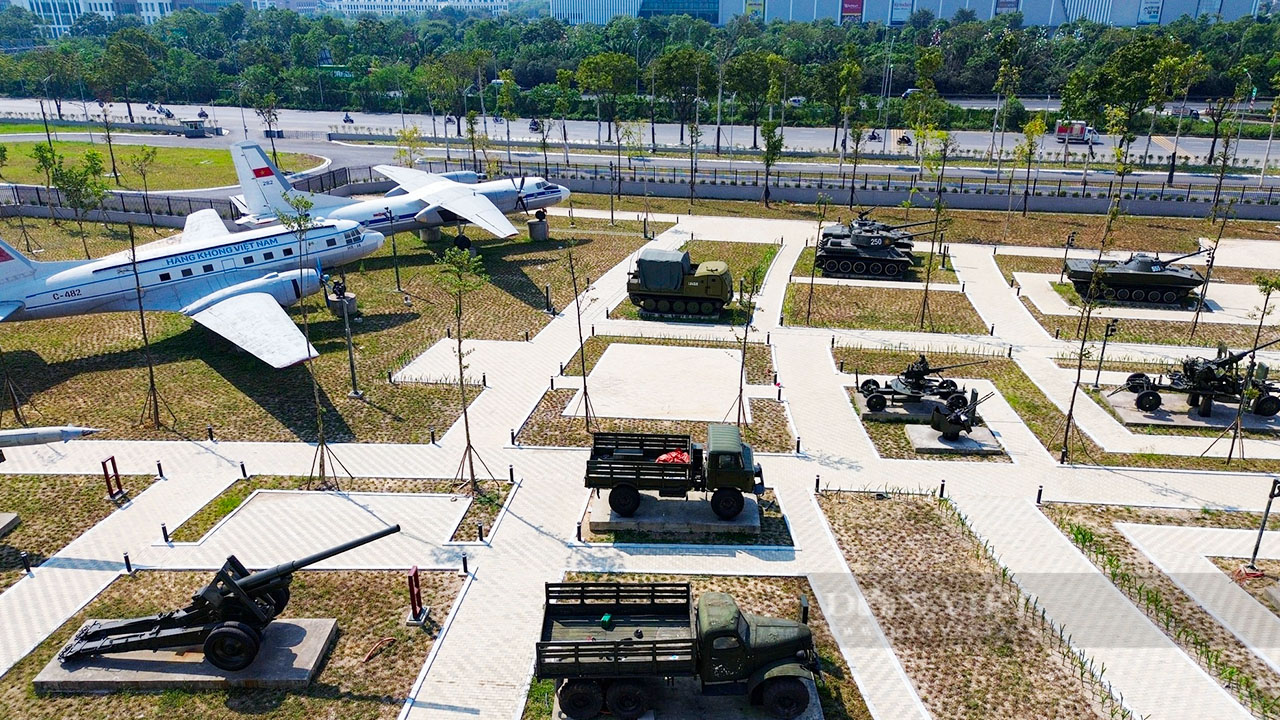
Guided Tours and Audio Guides
To enrich the immersive experience at the Vietnam Military History Museum, the facility offers structured guided tours and personalized audio guides, each designed to elevate the visitor’s understanding of Vietnam’s complex military heritage. These guided tours, available in English, French, and Vietnamese, provide a curated walkthrough of the museum’s vast collection, allowing visitors to delve deeper into the narratives behind each artifact.
The guided tours, which require booking in advance, ensure that each story within the museum is told with the depth and context it deserves. They provide a unique opportunity for guests to engage interactively with the museum while gaining insights from knowledgeable guides adept in the intricacies of Vietnam’s military innovations and historical milestones.
Additionally, the museum offers audio guides available for rent at 50,000 VND, approximately $2.20 USD. These guides extend the freedom to explore the museum at one’s own pace, delivering detailed commentary on each section of the museum. This option caters to those who may prefer a more individualized educational journey through the museum, enabling a richer comprehension of Vietnam’s past military engagements.
The availability of both guided tours and audio guides underscores the museum’s commitment to providing a comprehensive and educational experience. These offerings not only enhance the engagement of visitors but also ensure that each narrative whether it’s a tale of valor, strategy, or resilience is accessible to everyone uniquely.
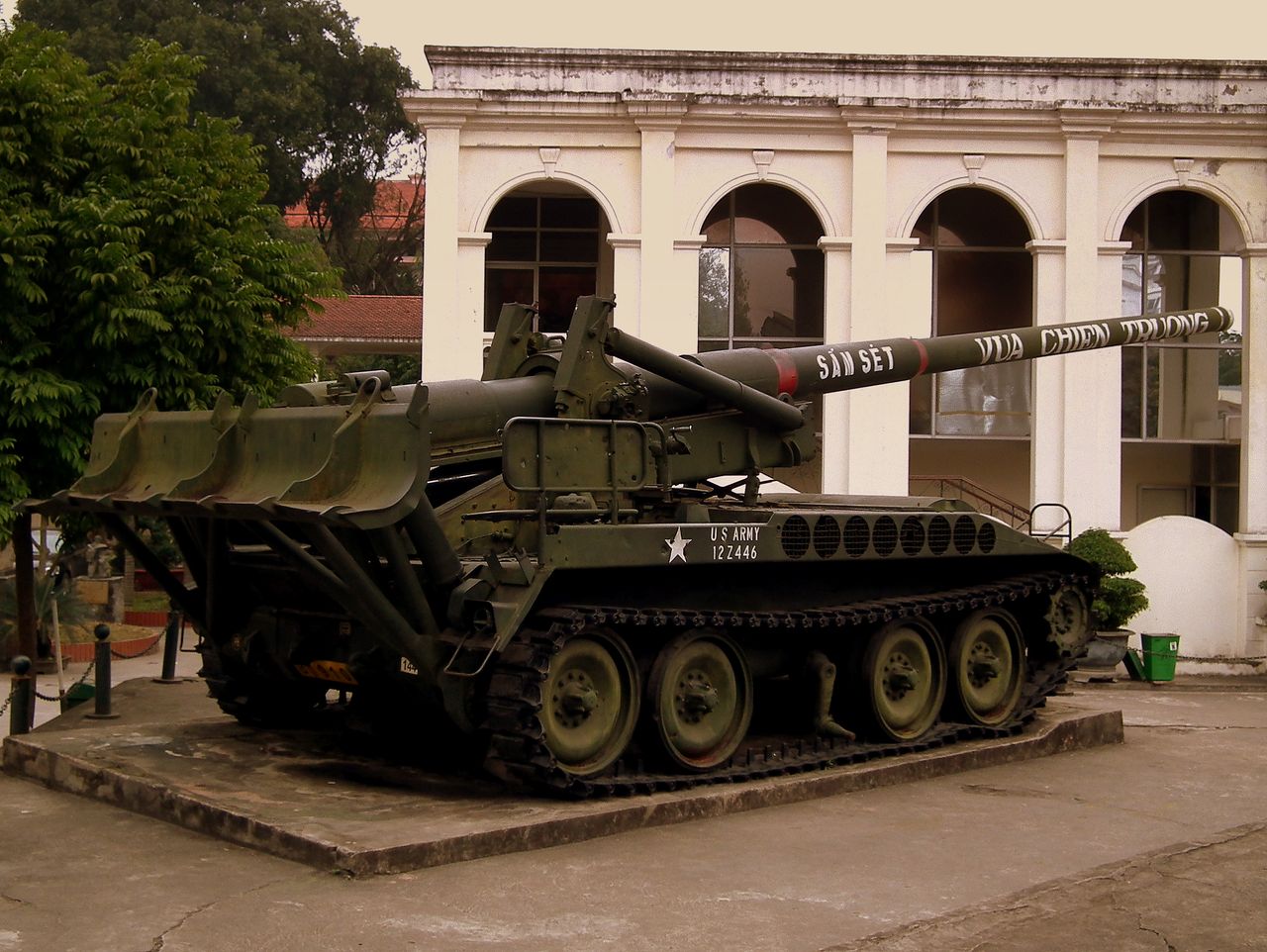
Facilities and Amenities
Ensuring a comfortable and informative visit, the Vietnam Military History Museum integrates a suite of facilities and amenities thoughtfully designed for all visitors. The museum spans approximately 12,800 square meters, incorporating three exhibition halls, an open-air display area, and the historical Flag Tower of Hanoi. This architectural composition caters to both the narrative and spatial needs of all attendees, providing an enriching cultural and historical experience.
The museum’s accessibility commitment is evident in its provision of wheelchair-friendly pathways, ramps, and elevators, ensuring inclusive navigation for visitors with mobility challenges. This enhances the experience, making the immersive exploration of Vietnam’s enriched military history accessible to all.
Visitor comfort is prioritized through ample restroom facilities scattered throughout the museum premises, ensuring convenience at every step of the tour. A well-stocked gift shop stands ready to offer visitors an array of memorabilia and educational resources to commemorate their journey through the Vietnam Military History Museum.
Where dining is concerned, while no on-site café exists within the museum grounds, a plethora of dining options scatter close by, echoing the vibrant culinary landscape of Hanoi. These nearby eateries offer ample opportunity for visitors to relax and digest the breadth of information encountered at the museum over a meal.
Overall, the facilities and amenities provided by the Vietnam Military History Museum go beyond basic needs, ensuring that each visit is as comfortable, convenient, and enriching as possible, further enhancing the museum’s status as a premier destination for enthusiasts of history and military craftsmanship.
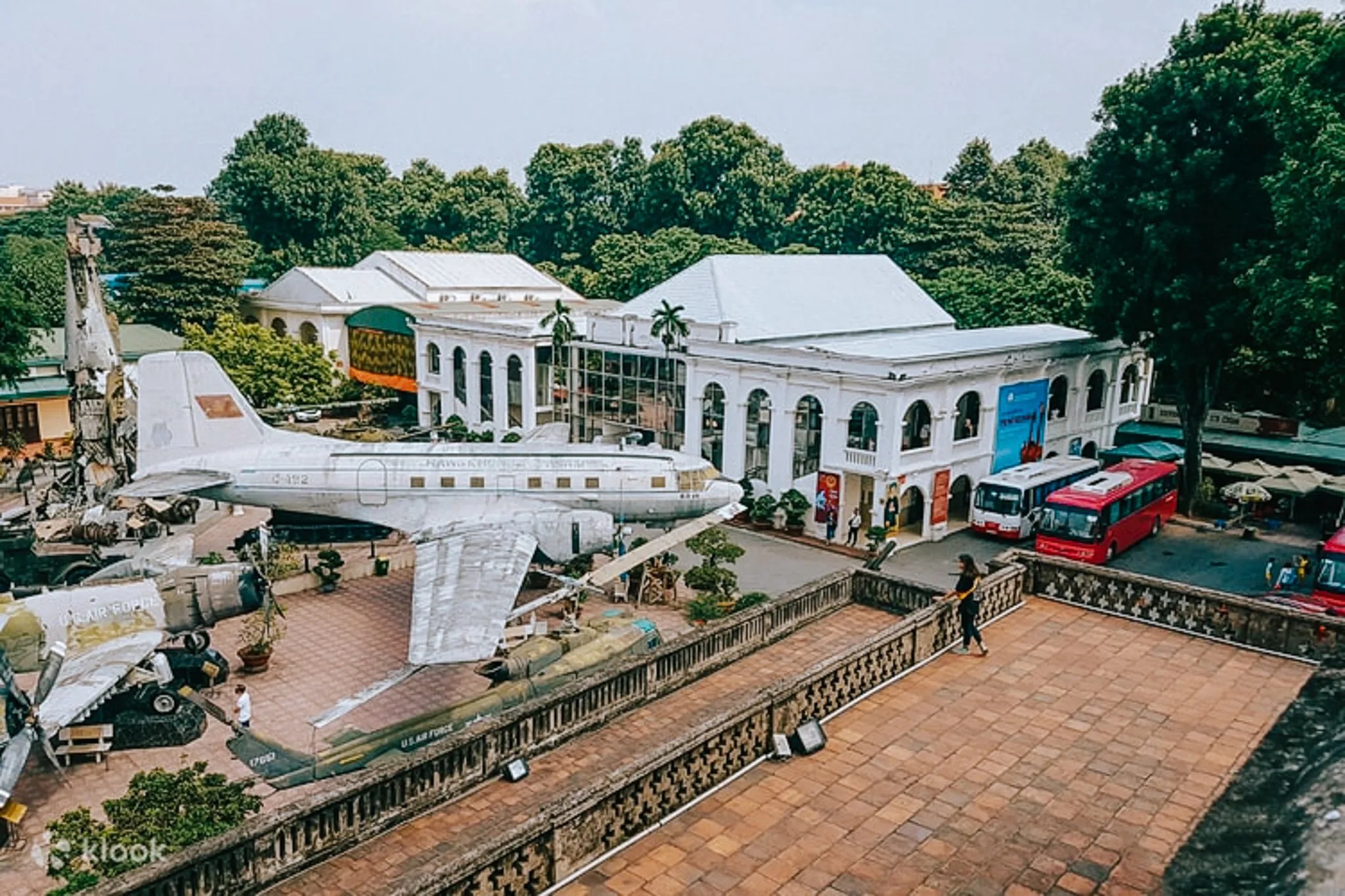
Notable Attractions Within the Museum
The Vietnam Military History Museum presents an insightful exploration of its unique attractions, each committed to narrating Vietnam’s vibrant military heritage. The museum’s exhibits range from intimate personal stories to grand retellings of epic battles, elegantly displaying the power of resilience, strategy, and unity. Visitors are encouraged to delve into the various notable attractions that encapsulate Vietnam’s military evolution vividly.
By exploring the main attractions, guests engage with Vietnam’s decades-spanning narratives through interactive exhibits and indispensable artifacts. The museum brings to life stories of national pride and sacrifice, inviting visitors to appreciate the profound cultural and historical significance enshrined within its walls.
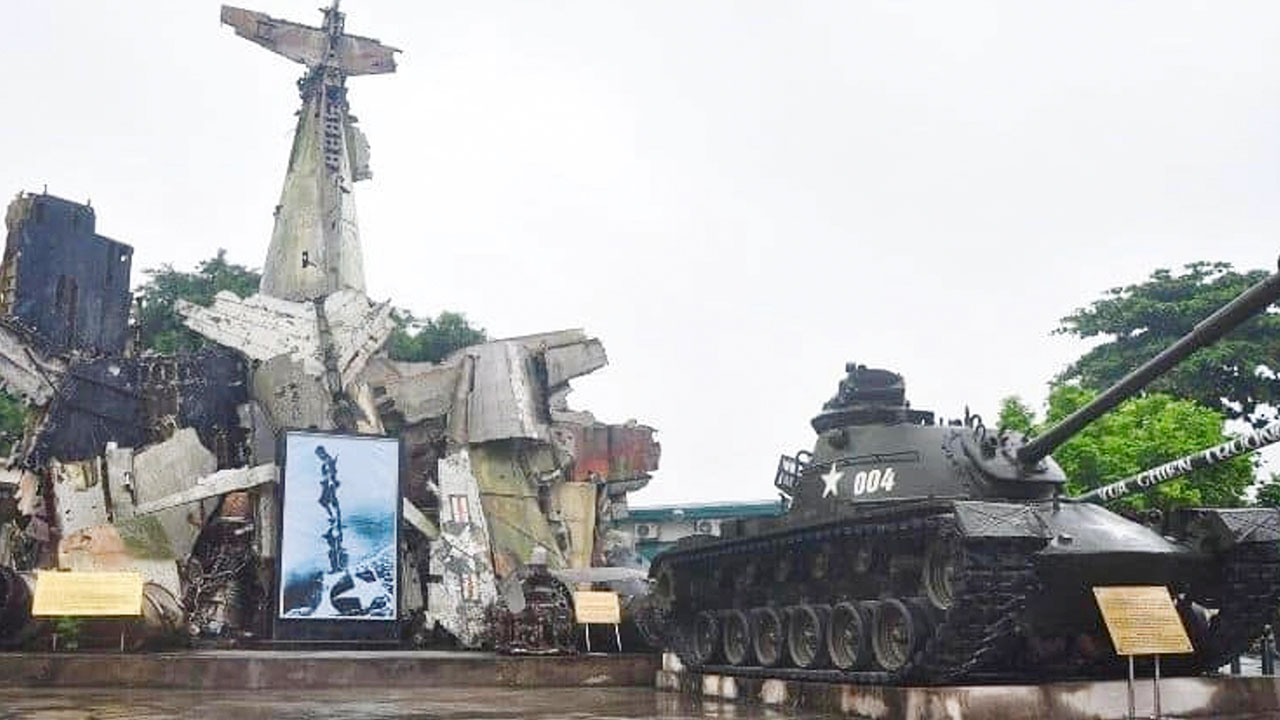
The Flag Tower of Hanoi
A quintessential emblem of Vietnam’s historical architecture, the Flag Tower of Hanoi stands sentinel within the Vietnam Military History Museum’s bounds. Constructed in 1812 during the Nguyen dynasty, this prominent structure serves as a symbol of national pride and resilience. Originally conceived as an observation post, its stature remains a steadfast fixture amidst Vietnam’s evolving cultural and political landscape.
The Flag Tower, standing at an imposing 33 meters tall, invites visitors with its towering presence. Its construction, characterized by intricate brickwork and strong lines, speaks to the architectural foresight of its era, capturing the glory and power of the dynastic empires that once ruled. The flag unfurling at its peak is a potent reminder of Vietnam’s ongoing journey towards unity and sovereignty.
The tower presents an engaging contrast against the museum’s modern amenities, providing visitors with panoramic views over a vibrant Hanoi teeming with historical treasures. Its role as a visual compass amidst the sprawl of artifacts and exhibits draws visitors into a deeper appreciation of Vietnam’s historical context and evolving narratives. Whether pondering history or simply admiring the view, the Flag Tower of Hanoi offers a unique vantage point from which to reflect on the stories housed within the Vietnam Military History Museum.
The Flag Tower remains a significant draw to the Vietnam Military History Museum, channeling the strength and grace that resonates from its stature into the museum’s enduring charm. This bold yet serene landmark stands proudly, engaging visitors in the timeless journey of Vietnam’s enduring pursuit of freedom and independence.

The Garden of Toys
Engaging visitors with an eclectic exhibition of military ingenuity, the Garden of Toys offers insight into the Vietnam Military History Museum’s outdoor allure. This captivating space teems with an array of captured and decommissioned military hardware remnants of Vietnam’s skilled defense and tactical brilliance.
An open-air repository of history, the Garden of Toys unveils authentic artifacts shaped by war, including tanks, artillery, and aircraft. These items tell the stories of military engagements and strategies devised by Vietnamese forces during significant wartime encounters. As visitors navigate this area, the experience resonates with the contrasting reality and resilience of war amidst a peaceful garden.
Significant pieces like the Soviet-made T-54 tanks sit firmly within the Garden of Toys, serving as demonstrative symbols of Vietnam’s technological adaptations and strategic wit used against formidable opponents. Each artifact, from the fragmented remains of French fighters to robust jeeps, bears the distinct scars of conflict, narrating the enduring legacy of battles won and lessons learned.
In many regards, the Garden of Toys captivates by blending military might with reflection transforming seemingly lifeless equipment into an educational and poignant storied landscape. As visitors traverse this distinctive garden, they connect deeply with Vietnam’s past struggles and triumphs, exploring firsthand the engines of history that turned the tides toward an indomitable legacy.

The Ho Chi Minh Trail Replica
Greatly enhancing the Vietnam Military History Museum’s appeal, the Ho Chi Minh Trail Replica offers a deeply immersive glance into the ingenuity and resilience behind one of Vietnam’s most famed military achievements. As a historically significant supply route during the Vietnam War, the Ho Chi Minh Trail was instrumental in transporting troops and supplies from North to South Vietnam, allowing for the strategic undermining of American forces.
Located within the museum’s bounds, this replica captures the essence of the original trail, rendering a real-time simulation of the treacherous terrains navigated by the brave. The museum showcases diverse equipment, vehicles, and models highlighting the logistics and strategies employed along the trail, creating a vivid illustration of its significance.
The Ho Chi Minh Trail Replica provides visitors with a sensory journey through strategic military triumphs, underscoring the tactical acumen of Vietnamese forces amid adversity. By enabling visitors to step back in time and retrace the tracks of soldiers who traversed jungles, rivers, and mountains, the exhibit brings history to life, engaging them in the dramatic tales of war and resilience.
As a centerpiece attraction, the Ho Chi Minh Trail Replica fosters a narrative-rich experience, deepening the understanding of Vietnam’s strategic capacities throughout the war. Through vivid simulations, it chronicles an era of resourcefulness and determination and offers an homage to the unyielding spirit that drives the Vietnamese towards remembrance and strength in unity.
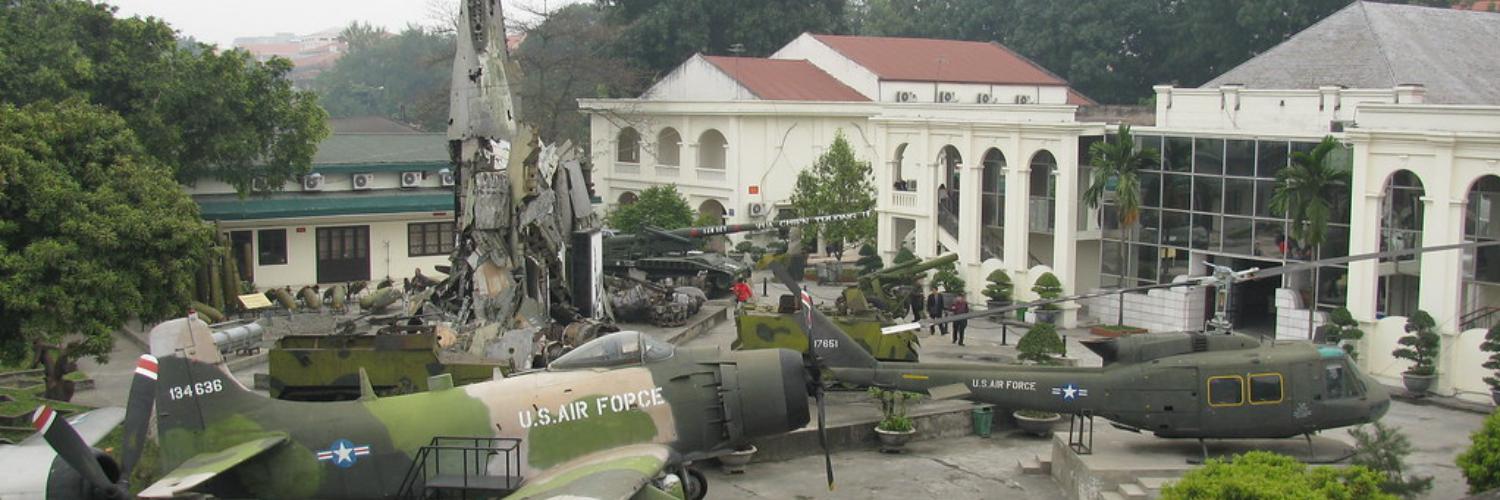
Educational Opportunities
The Vietnam Military History Museum reveals a realm of educational potentials through its well-curated exhibits and informative resources. Situated within the heart of the museum are various notable attractions, each emphasizing the need for deeper inquiry and academic appreciation of Vietnam’s military history. These attractions combine picturesque storytelling with educational immersion, inviting visitors to explore and understand Vietnam’s diverse narrative landscapes.
Each exhibit is a portal that crafts insights into Vietnam’s evolving military strategies, with thematic workshops complementing tailored visitor engagements. Through guided tours and exhibits, the museum facilitates a multifaceted learning experience, instilling an awareness that transcends genera and boundaries. The Vietnam Military History Museum provides a nurturing platform for appreciation and growth, fostering a wave of learning that resonates into future generations.
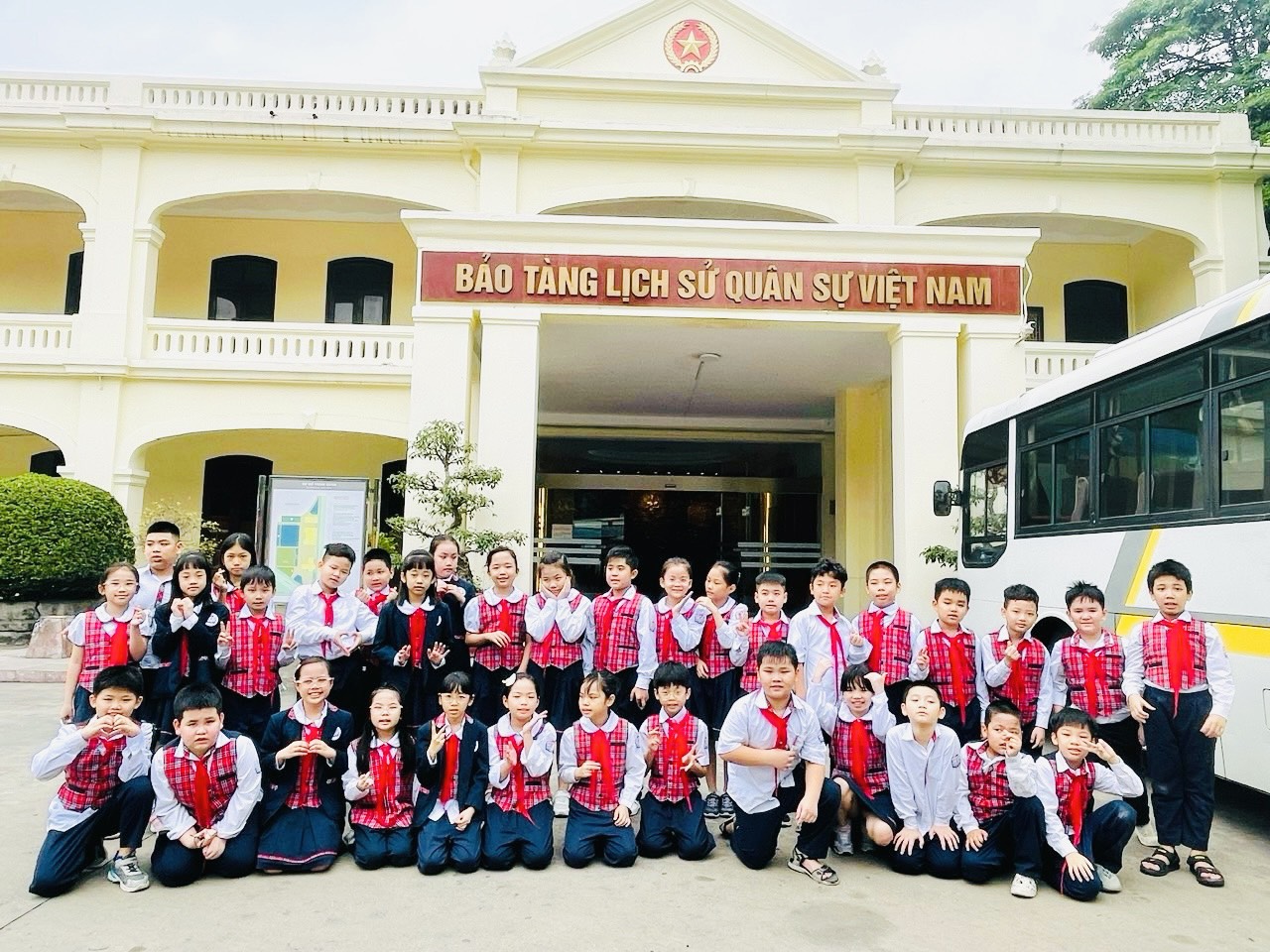
Learning Programs and Workshops
In its dedication to education, the Vietnam Military History Museum offers structured learning programs and workshops, designed to enrich understanding of Vietnam’s complex military history. Each program comprises an immersive exploration engaging visitors, especially students and educators, in a compelling narrative journey through diverse exhibits and resources. Aimed at offering insight into Vietnam’s historical milestones, these programs facilitate comprehensive and interactive learning experiences.
The museum caters to educational institutions by providing guided tours tailored for school groups, where facilitators effectively bridge the past and present through interpretive stories and contextual discussions. These guided programs, conducted in multiple languages, enhance educational visits and instill a deeper understanding of Vietnam’s evolving military narratives.
Practical workshops, often conducted around artifacts, allow participants to engage directly with exhibits. These sessions complement theoretical knowledge with tangible experiences, encouraging interactive participation through diverse activities such as artifact analysis, model-making, and tactical reenactments. Each workshop progressively strengthens understanding, offering insights into strategies, innovation, and personal experiences during Vietnam’s military engagements.
For educators and students aiming to explore the vast collection within the museum, specialized educational material and resources are available, promoting self-guided learning. These resources guide students through the various exhibits, supplementing visitation with illustrative data that aligns with curricular studies. The museum’s research resources supplement the workshops, enabling visitors to delve deeper into the contexts of Vietnam’s patriotic heritage.
In essence, the Vietnam Military History Museum’s educational programs and workshops serve as a multifaceted re for evolving learning styles, ensuring Vietnam’s military heritage continues to educate, inspire, and inform all who seek to understand the past profound impacts and enduring relevance.
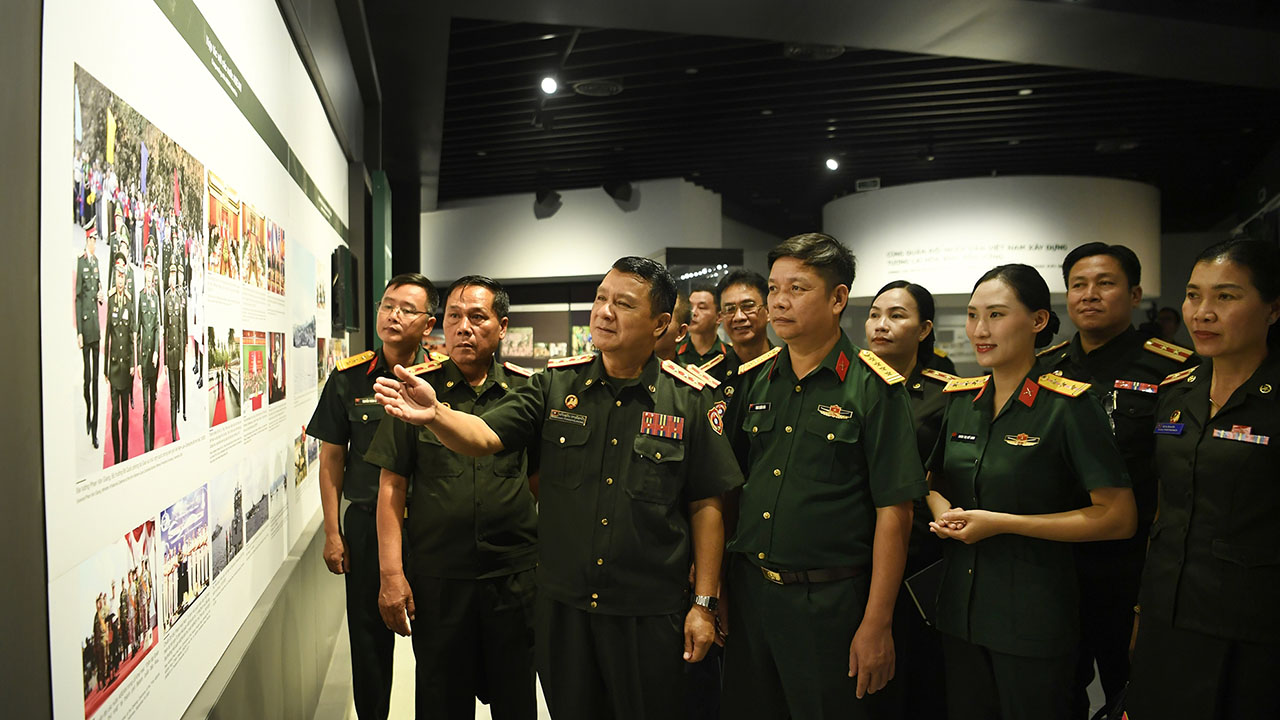
Research Resources Available
As an epicenter of historical knowledge, the Vietnam Military History Museum provides extensive research resources designed for scholars, educators, and history enthusiasts. These resources enable a deeper examination of Vietnam’s rich military history, extending scholarly pursuits beyond the surface level of typical exhibits to encompass a comprehensive study of Vietnam’s military legacy.
The museum’s expansive collection, comprising over 150,000 artifacts, forms the foundation of its research capabilities. Each artifact, with detailed docuseries and archives, offers valuable insights into military strategies, technologies, and personal narratives, collectively shaping Vietnam’s historical landscape. This repository of tangible and documented history serves not only academic purposes but ensures the preservation of Vietnam’s rich cultural heritage for generations to come.
The museum facilitates structured access to a variety of resources such as scale models, annotated maps, and detailed analysis reports that meticulously capture pivotal seasons of Vietnam’s military past. Researchers and students can utilize these resources to examine aspects like battlefield tactics, diplomatic strategies, and socio-economic impacts, affording an in-depth appreciation of Vietnam’s past confrontations and victories.
In addition to physical resources, the museum embraces modern technology through its digital archives, offering accessible content for scholars and individuals worldwide. These digital archives include curated collections, high-resolution images, and comprehensive exhibits available to remote researchers, expanding the museum’s educational outreach and scholarly engagement.
By providing extensive resources, both on-site and digital, the Vietnam Military History Museum offers a robust platform for academic pursuits and advanced studies in Vietnamese and global military history. Its unparalleled access to primary artifacts harnesses Vietnam’s storied legacy, ensuring the past’s relevance remains influential in today’s continuing quests for knowledge and understanding.
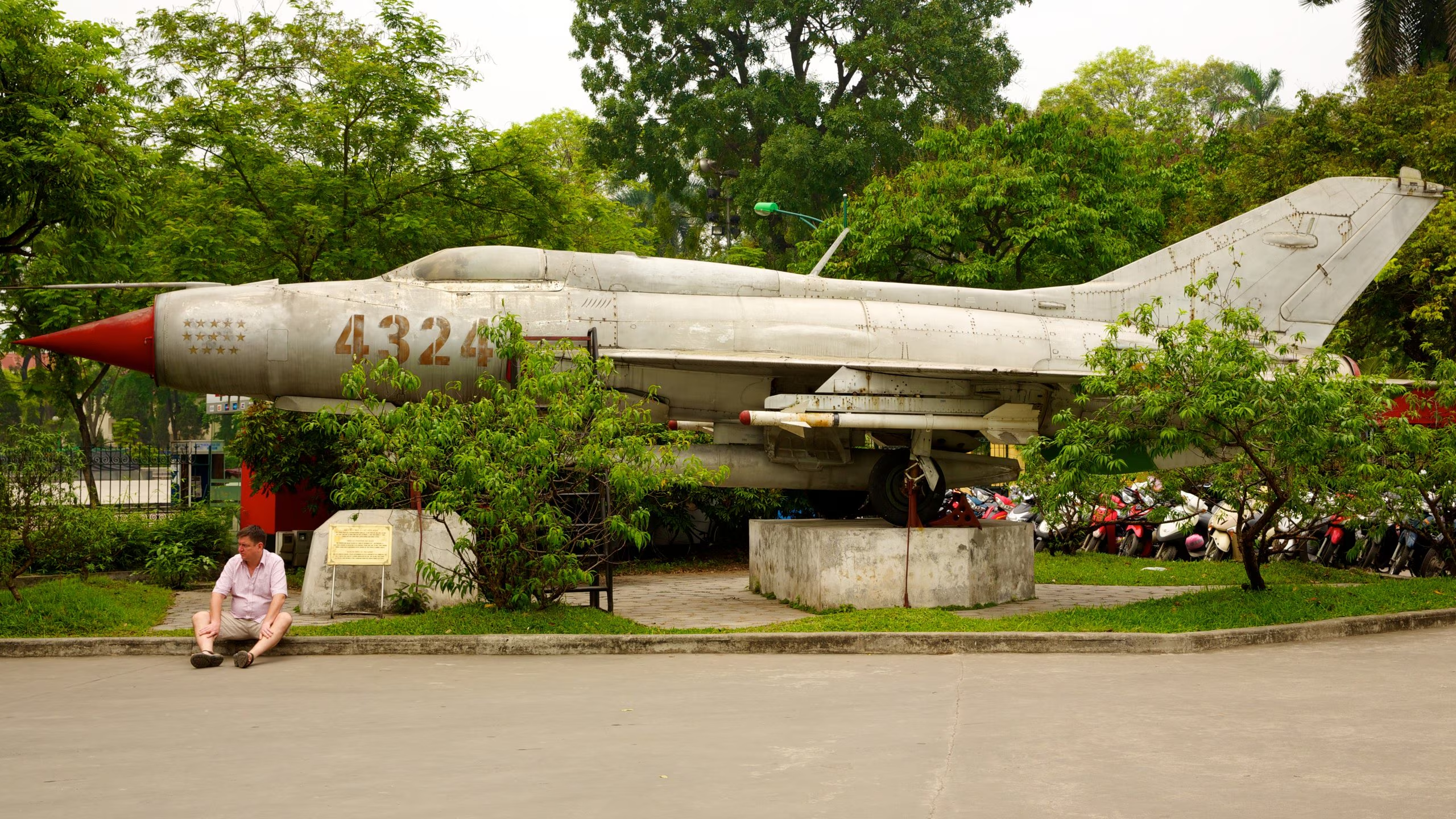
Visitor Reviews and Feedback
As the Vietnam Military History Museum continues to draw visitors, it relishes a plethora of insightful reviews and feedback which provide a balanced narrative of its broader appeal and areas for enhancement. Harnessing the voices of its audience, the museum embarks upon an evolving journey, ensuring that each interaction is as enriching and educational as the stories enshrined within its walls.
The resonance of educational opportunities becomes apparent as visitors share tributes to the museum’s immersive venues, noteworthy exhibits, and invaluable learning experiences garnered. Commentaries and reviews serve both as endorsements and constructive foresight, propelling the Vietnam Military History Museum’s ongoing commitment to delivering meaningful, memorable narratives and interactions for all who walk its halls.

Highlights from Visitor Experiences
Those who visit the Vietnam Military History Museum frequently praise its depth of content, capturing the attention of both casual tourists and dedicated history aficionados. The museum provides a vivid depiction of Vietnams complex yet compelling military history, transferring narratives from the past into vivid displays and interactions that resound with authenticity.
Many visitors express enthusiasm for the museum’s diverse array of artifacts, some extending their adoration towards exhibits like the MiG-21 aircraft and the historical significance of the T-54B tank. These artifacts are often applauded for their intricate representations of military prowess and their contextual stories of sacrifice and valor. Outdoor displays, notably decommissioned machinery in the Garden of Toys, consistently garner admiration as poignant storytellers of resilience.
Visitor feedback often accentuates the well-curated exhibitions, extolling the significant educational value derived from engaging with each exhibit. The museum’s interactive learning programs, from guided tours to resourceful workshops, receive generous commendations for facilitating comprehensive understanding through structured storytelling.
Families and educational groups are particularly enamored by the museums affordable prices and inclusivity, with educators praising the museum’s role in facilitating well-informed school visits and academic pursuits. The accommodating manner of staff and facilitators, coupled with an amenity-rich environment, ensures each visit to the museum delivers both comfort and intellectual stimulation.
Across platforms like TripAdvisor and Google Reviews, a common sentiment prevails one of enlightenment punctuated by a sense of awe. Visitors consistently cherish the experiences fostered within the Vietnam Military History Museum, providing testimonies rich in engagement that reflect the museums commitment to education, storytelling, and historical reverence.
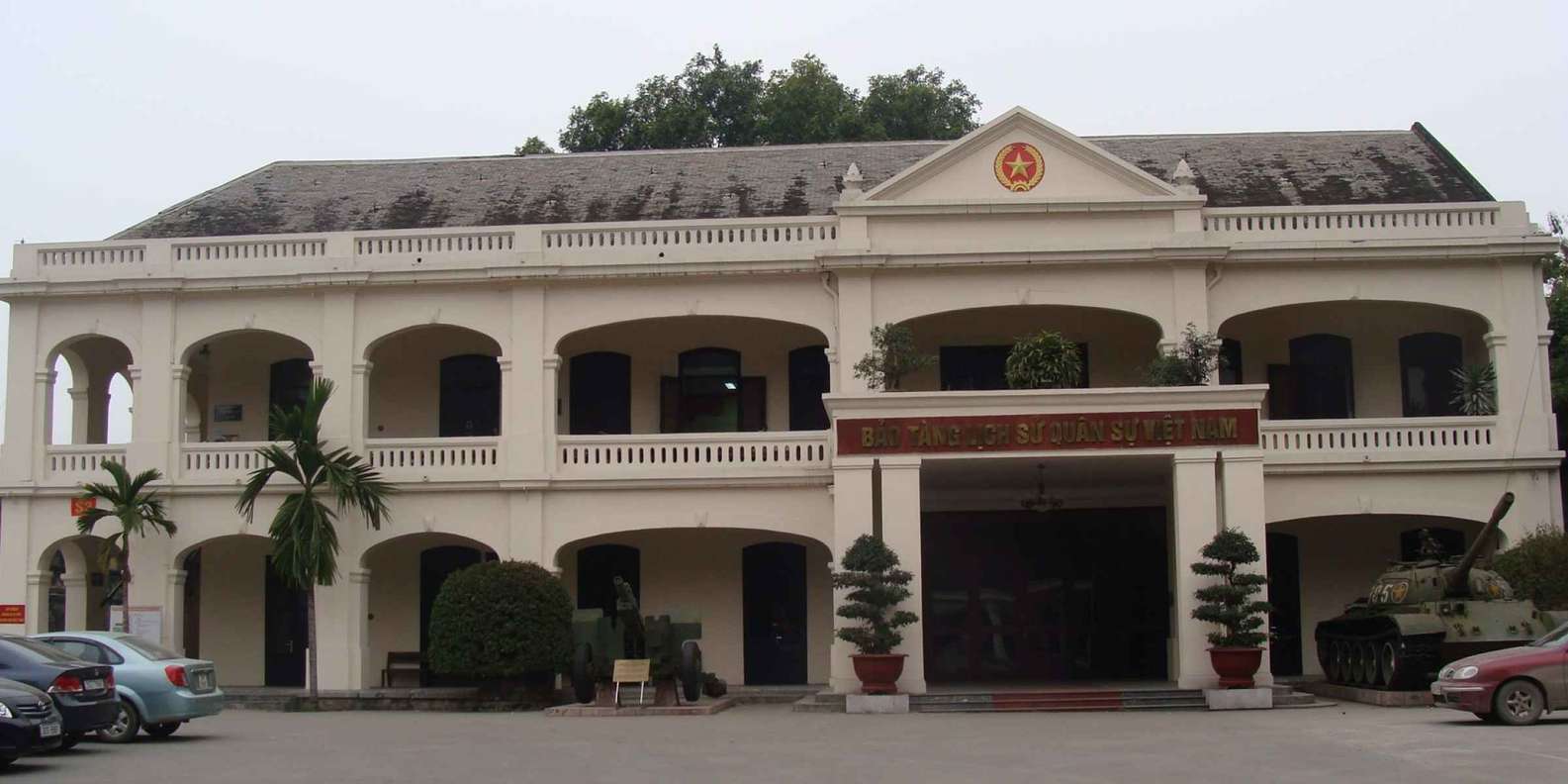
Common Critiques and Suggestions
Although the Vietnam Military History Museum enjoys widespread acclaim, it remains receptive to critiques and suggestions directed by keen observers. Constructive feedback acts as the museum’s guiding torch, ensuring each visit remains impactful and fulfills its historical mandate.
Common critiques often focus on signage clarity, with some visitors expressing a desire for heightened navigational ease. While the museum offers rich narratives through well-curated exhibits, the introduction of additional signage, including text overlays and region guides, could further enhance the visitor experience, streamlining paths through entwined stories and displays.
Another area of concern highlighted in feedback is the limited availability of exhibits, specifically those relocated to other sites. Visitors who journeyed with expectations to witness particular artifacts voiced their disappointment when these items were unavailable, prompting suggestions for improved communication and updated information on the current state of exhibits.
A recurring observation noted during peak visit times revolves around the limited opening hours, particularly on Mondays and Fridays. This has led to suggestions for extended operating intervals or enhanced notice, allowing patrons ample opportunity to integrate museum visits with varied itineraries.
While some critiques circle around logistical aspects, they highlight the museum’s willingness to evolve and adapt to guest expectations. Suggestions ranging from enhanced wayfinding to extensive operating information only bolster the museum’s relevance as it strives to exceed visitor expectations, shaping a more streamlined and inclusive experience for enthusiasts eager to explore Vietnam’s storied military past.
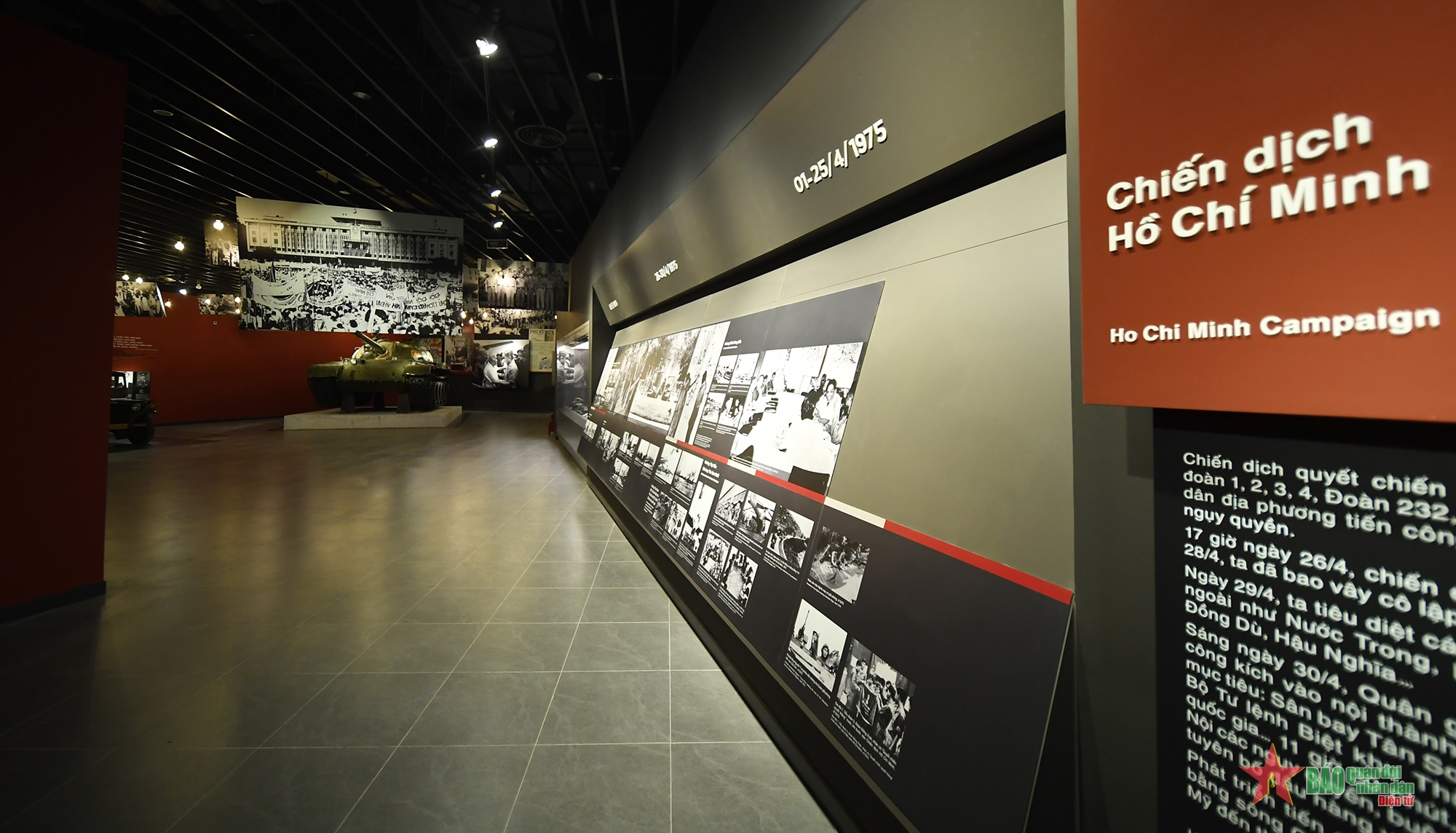
Nearby Attractions
As the Vietnam Military History Museum continues to captivate visitors with its profound narratives and exhibits, its strategic location within Hanoi enchants guests with a veiled tapestry of nearby attractions. These attractions provide visitors an expanded insight into Vietnam’s cultural and historical fabric, extending the museum’s educational and historical intrigue to neighboring landmarks. Vibrant cultural sites and museums radiate in close proximity, offering visitors a rich array of experiences that elegantly complement their journey through the Vietnam Military History Museum.
Together, these attractions seamlessly weave a dense fabric of Vietnam’s diverse historical narrative, inviting guests to explore facets of culture and heritage closely tied to both the museum’s storylines and the heart of Hanoi.

Other Museums in Hanoi
With Hanoi serving as a hub for historical and cultural tourism, visitors enjoy a wealth of other museum experiences alongside their exploration of the Vietnam Military History Museum. Each nearby museum provides a unique lens into Vietnam’s rich history, heritage, and contemporary evolution, offering compelling insights that complement a visit to the military history sanctuary.
Among these, the Vietnam Museum of Ethnology stands out as a must-see destination, providing an immersive journey into the nations diverse ethnic cultures. Visitors can engage with traditional artifacts, reconstructed homes, and multimedia exhibits depicting Vietnam’s ethnic groups, enhancing understanding of Vietnam’s multifaceted cultural tapestry. The museum serves as a poignant contrast to the military-focused narratives, focusing instead on the intricate interplay of cultural identities.
Another intriguing venue is the Hoa Lo Prison Museum, infamously known as the “Hanoi Hilton.” Located a short distance from the Vietnam Military History Museum, this museum delves into the harrowing experiences faced by Vietnamese and American prisoners during the Vietnam War. The museum offers preserved prison cells, artifacts, and personal narratives, exploring both historical trauma and resilience.
For art enthusiasts, the Vietnam National Museum of Fine Arts unveils an array of traditional and contemporary Vietnamese artworks. From ancient sculptures to modern interpretations of cultural themes, the exhibits demonstrate the vibrant artistic evolution of Vietnam.
Lastly, the National Museum of Vietnamese History rounds out the Hanoi museum circuit, offering a vast collection exploring Vietnam’s long historical timeline, from prehistoric cultures to contemporary accomplishments in science and arts.
Through these auxiliary museum visits, guests experience a breadth of historical and contemporary narratives essential to understanding Vietnam’s manifold identity. Each museum captures unique aspects of the nation’s story while collectively enriching an exploration of Hanoi’s diverse historical pulse.

Cultural Sites and Landmarks Nearby
Hanoi’s vibrant landscape offers a medley of cultural sites and landmarks, providing a harmonious complement to the Vietnam Military History Museum’s historical insights. These proximate sites embrace rich narratives, enhancing the cultural scope of any visit to the museum by connecting Vietnam’s military past with its dynamic present.
Adjacent to the museum, the Ho Chi Minh Mausoleum emerges as a significant landmark, hosting the preserved remains of Vietnam’s revered leader, Ho Chi Minh. This mausoleum invites visitors to pay respects and engage with the country’s revolutionary origins and the figure who played a pivotal role in Vietnam’s vibrant history.
Cultural exploration is further accentuated by visits to the One Pillar Pagoda, famed for its unique architectural design inspired by a lotus blossom. This Buddhist temple evokes tranquility amidst Hanoi’s bustling streets and offers profound spiritual insights.
Another worthy stop is the Thang Long Imperial Citadel, a UNESCO World Heritage site located conveniently near the museum. This historical complex bears witness to a millennium of Vietnam’s imperial past, offering visitors an entree into Vietnam’s regal history and architecture through ages.
For those inclined towards performance arts, the Hanoi Opera House stands majestically nearby, drawing visitors with its opulent architecture and diverse array of performances, from classical operas to traditional Vietnamese theater, offering a contrasting medium to engage with cultural vibrancy.
The juxtaposition of the Vietnam Military History Museum with these cultural landmarks illustrates a dynamic fusion a balanced tapestry of history, military legacy, and cultural richness encouraging visitors to fully explore and embrace the heart of Vietnam’s heritage.
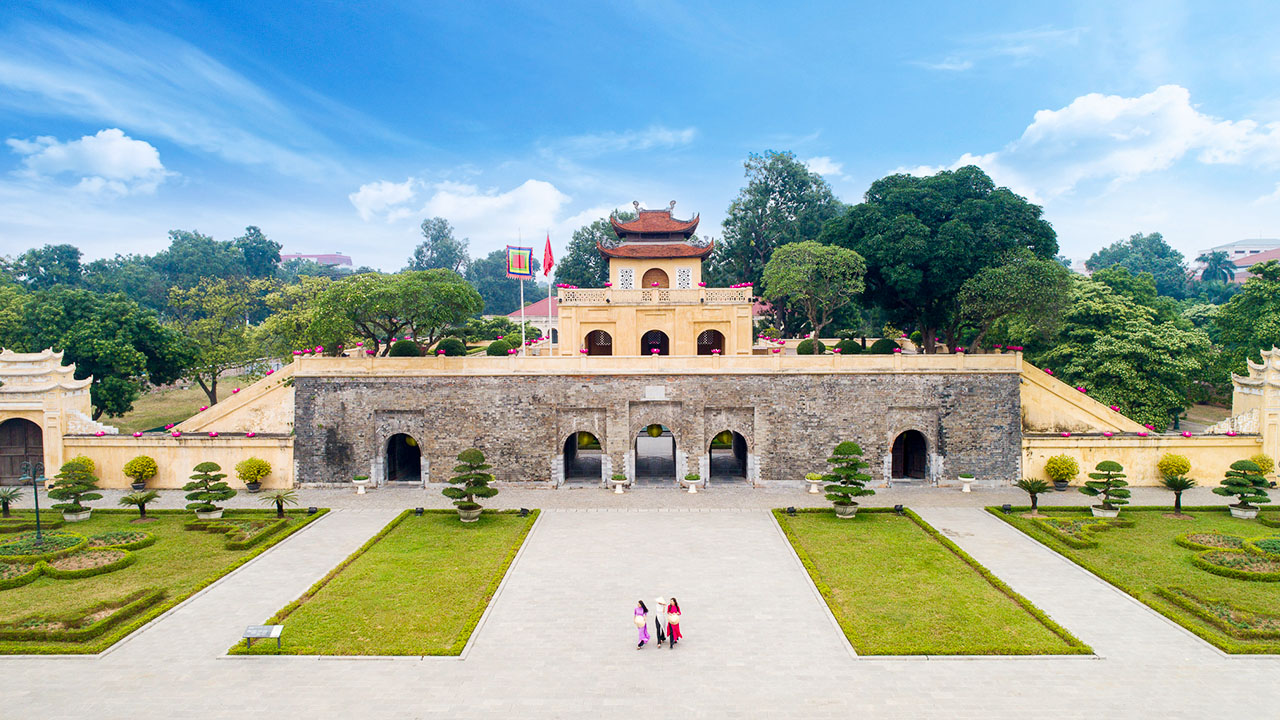
Special Events and Exhibitions
As guests explore the Vietnam Military History Museum in its entirety, they uncover a varied tapestry of special events and exhibitions designed to resonate deeply with enthusiasts of history and culture. The museum’s dynamic calendar hosts a rich array of events, celebrating historic milestones and vital military anniversaries. These commemorative gatherings invite visitors to delve deeper into the evolving tapestry of Vietnam’s patriotic legacy and military achievements.
Aligned with nearby attractions, these events enhance the overall visitor experience, weaving enriched narratives into Hanoi’s vibrant cultural landscape. Each occasion and exhibition emerges as an encapsulation of Vietnam’s enduring story, fostering a sense of inquiry, reflection, and appreciation for the country’s storied journey through history.
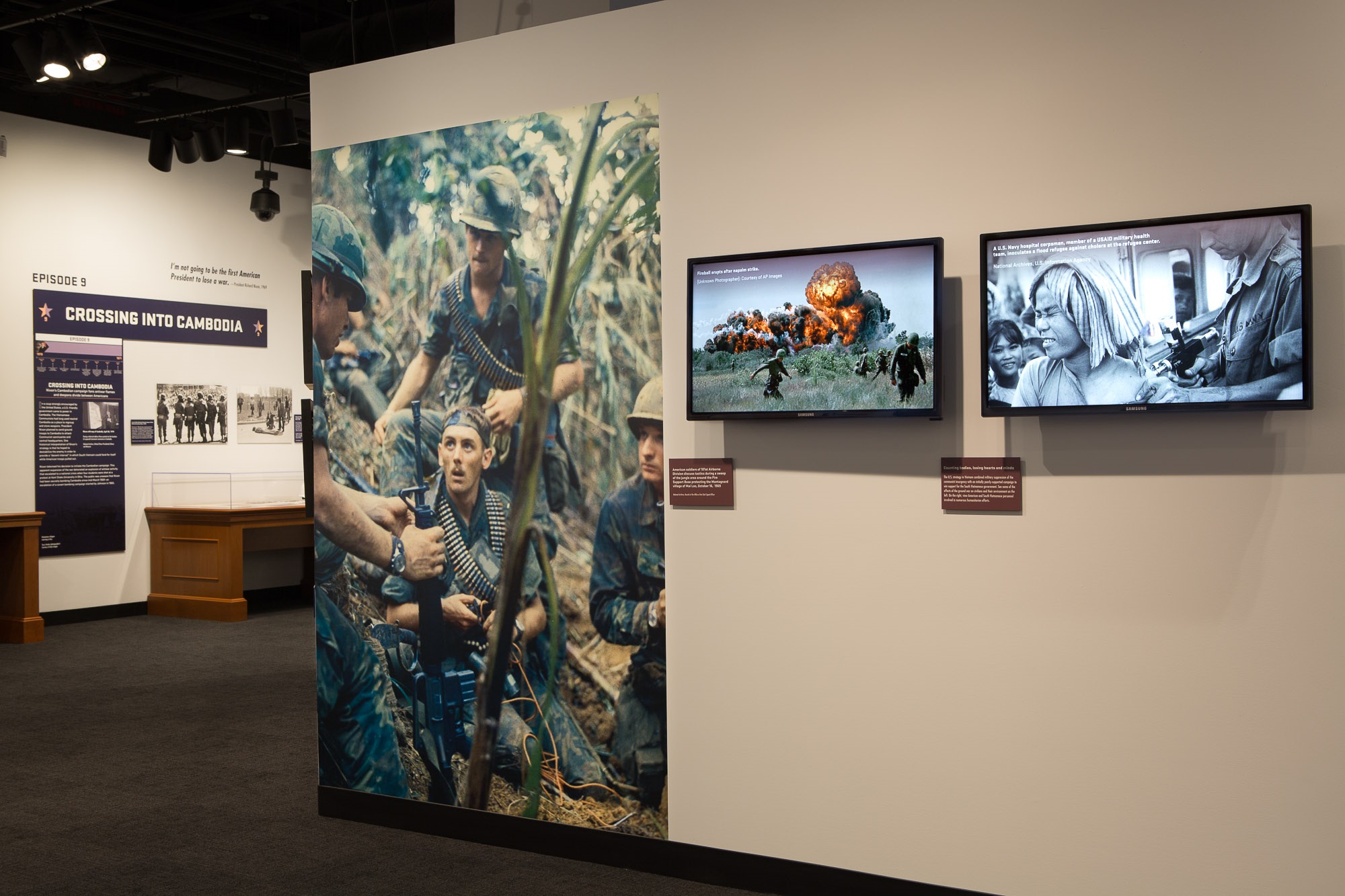
Annual Commemorations
The Vietnam Military History Museum commemorates vital moments in Vietnam’s martial history with significant annual events, offering vivid narratives that reinforce the country’s enduring legacy. These annual commemorations acknowledge the national and personal sacrifices that have shaped Vietnam’s destiny, inviting visitors to partake in enriching experiences enveloped by tales of valor and resilience.
Each year, the museum hosts celebrations for significant anniversaries such as the Vietnam War Veterans Day, paying tribute to the valor of those who served in Vietnam’s defining conflicts. These commemorations are characterized by tribute ceremonies, dedications, and reflections that foster a profound sense of gratitude and remembrance.
The museum also organizes special exhibitions surrounding milestones like the Dien Bien Phu Victory and other pivotal moments that exemplify strategic success and liberation from colonial rule. These exhibitions employ artifacts, documents, and personal testimonies, offering a multi-faceted perspective on Vietnam’s trials and triumphs.
Throughout enrollment, the museum emphasizes educational programming via seminars, panels, and narrative discourses, engaging visitors in discussions about Vietnam’s military strategies and international relations throughout history. By delving into multilayered interactions, guests are encouraged to examine contemporary implications of historical events, fostering dialogues about enduring impacts.
The diverse assortment of annual commemorations within the Vietnam Military History Museum punctuates a commitment to celebrating Vietnam’s martial prowess, engaging participants with richly documented and reflective chronicles reinforcing the nation’s continuing narratives of bravery and unity.

Temporary Exhibitions and Themes
Beyond landmark exhibitions, the Vietnam Military History Museum extends its narrative reach through well-curated temporary exhibitions designed to evoke thematic reflections and amplify insightful engagements with visitors. These exhibitions explore Vietnam’s military history through fresh perspectives, engaging visitors with a dynamic and ever-evolving tapestry of narratives.
A key tenet of these exhibitions lies in their thematic focus, encapsulating features that explore specific facets or junctures in Vietnam’s martial history. The museum creatively dives into diverse subjects, ranging from the socio-political impacts of war on Vietnamese communities to the exploration of international discourse on conflict and resolution.
Temporary exhibitions might underscore advancements in military technology, showcasing how strategic innovation influenced Vietnam’s conquests. They offer robust interactions with curated artifacts, models, and multimedia exhibits that illustrate how these technologies evolved amid escalating battles.
Themes also extend to the personal facets of Vietnam’s military history. By presenting soldier narratives, familial bonds, and cultural symbols during wartime, the museum adds relatable dimensions of reflection to its comprehensive tale of strategy and survival.
The emphasis on engagement through these temporary exhibitions broadens visitor comprehension, invoking reflective dialogue on the intricacies of Vietnam’s military saga. Through well-orchestrated narratives, the museum ensures its legacy remains vibrant and accessible to all curious minds eager to explore the depths beyond chronological retellings.
FAQs
- What are the admission fees for the Vietnam Military History Museum?
- Admission is 40,000 VND for adults, while children under 15 and students enter for free.
- What are the operating hours of the museum?
- The museum operates daily except Mondays and Fridays, from 8:00 AM to 11:30 AM and 1:00 PM to 4:30 PM.
- Are guided tours available at the museum?
- Yes, guided tours are available in English, French, and Vietnamese. Booking in advance is recommended.
- What public transport options provide access to the museum?
- Bus routes 9, 18, 41, and 45 serve the museum area, with stops close by for convenient access.
- Does the museum offer educational resources or workshops?
- Yes, the museum offers learning programs and workshops designed to enhance visitor understanding of military history.
Key Takeaways
- The Vietnam Military History Museum holds significant historical relevance, exhibiting over 150,000 artifacts spanning Vietnam’s military history.
- It is strategically located in Hanoi, providing easy access by public transportation or private vehicles.
- Exhibitions are segmented into three main halls, each dedicated to specific periods and themes in Vietnam’s military past.
- The museum offers guided tours and audio guides, enhancing the learning experience with both educational depth and personal freedom.
- Notable attractions within the museum include the Flag Tower of Hanoi, the Garden of Toys, and the Ho Chi Minh Trail Replica, each narrating pivotal military narratives.
Conclusion
The Vietnam Military History Museum stands as a prominent cultural and historical portal within Hanoi, offering a captivating journey through Vietnam’s storied military past. It extends a multidimensional experience that captures the eerie beauty and harsh realities of battles fought and won, where every artifact, exhibit, and narrative intertwines to define Vietnam’s resolute path toward sovereignty and unity.
The museum’s seamless fusion of education, historical insight, and engagement ensures that it remains a beacon for those eager to elucidate Vietnam’s complex tapestry of history. As the museum opens doors to immersive learning and exploration, it strengthens Vietnam’s legacy by fostering an appreciation for past victories and a contemplative understanding of struggles endured. Whether through its enduring exhibitions or dynamic temporary displays, the Vietnam Military History Museum invites all to reflect, respect, and recognize the enduring power of Vietnam’s storied past.


